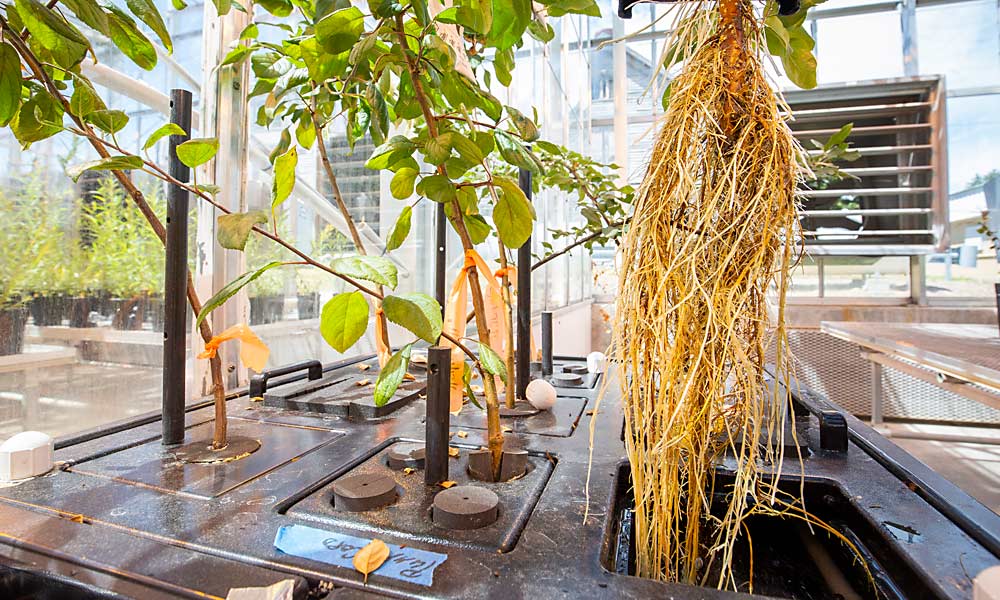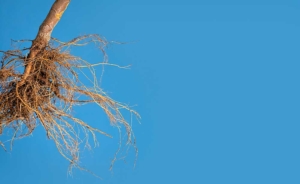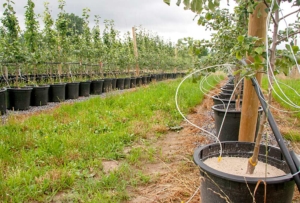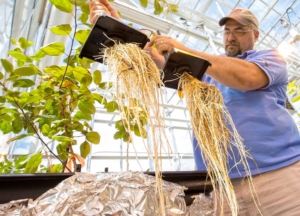
What’s the best rootstock for Honeycrisp?
Some might say Budagovsky 9, as many growers have observed that Honeycrisp on B.9 roots tends to develop less bitter pit.
That observation inspired the Root2Fruit project, a federally funded research project launched in 2016 to dive deeper into how rootstocks differ when it comes to nutrient uptake, replant disease resistance and tolerance for abiotic stressors such as salinity — and the ways growers can leverage those differences to benefit their production. Now, project researchers are starting to share their findings on replant disease and bitter pit management.
During the International Fruit Tree Association’s annual meeting, held virtually in February, Washington State University physiologist Lee Kalcsits and Cornell University physiologist Lailiang Cheng shared insights on what they’ve learned so far about rootstocks and their role in bitter pit.
Helping Honeycrisp
The influence of rootstock on bitter pit incidence can be significant, Kalcsits said, resulting from how rootstocks affect vigor, precocity, fruit size and nutrient uptake.
B.9 reduces bitter pit because it imposes the most water stress on the scion, he said. That results in smaller fruit, which are less prone to bitter pit. The reduced vigor also reduces the uptake and delivery of potassium to the fruit, which is important because Honeycrisp tends to develop bitter pit when there’s too much potassium relative to calcium.
On the other hand, Geneva 41 tends to take up potassium more than other rootstocks, which likely plays a role in why it consistently has one of the highest rates of bitter pit in the Washington trial data Kalcsits shared.
But rates of bitter pit may not be the best lens to use in selecting a rootstock for your Honeycrisp, Cheng said.
“It’s the bitter pit-free yield in the packout that sets the returns to you,” Cheng said. Packout matters most, so the picture changes when he switches from measuring the percentage of fruit with bitter pit to the bitter pit-free yield. Compared to a dozen other Geneva and Malling rootstocks in a Cornell trial, B.9 trees had the lowest bitter pit-free yield and G.41 had the highest.
“This is not to say that B.9 does not work,” Cheng said. “You can achieve good quality, but you are going to have to sacrifice the first few years or use grow-through trees.”
Understanding how B.9 reduces bitter pit also gives growers more insight into how to use management to control bitter pit on different rootstocks.
“We see that vigor and crop load management are really key to managing bitter pit,” Kalcsits said. With a biennial production cycle, the off years result in larger fruit and higher potassium-to-calcium levels that lead to higher bitter pit rates. “If you can get it out of its biennial cycle, it becomes more calm and easier to manage,” he said.
The goal for growers is to find the rootstock that helps hit the sweet spot between the competing production goals of filling space quickly, producing good yields and keeping bitter pit to a minimum, Kalcsits said. With that perspective, some rootstocks are more “forgiving” than others in terms of how much growers’ management can alter performance. B.9’s narrow vigor range can’t be boosted much by irrigation, fertilizer or cropping decisions, while G.890 is much more receptive to management, but also more prone to bitter pit — because, like G.41, it favors a potassium uptake.
Kalcsits said G.969 or G.214 offer more flexibility, delivering better potassium-to-calcium balance and also giving growers more vigor without necessarily paying a bitter pit penalty.
On the nutrient balance issue, Cheng said that as he and Mario Miranda Sazo, a Cornell extension specialist and doctoral student, wrap up their rootstock nutrient uptake trials over the next year, they hope to share more insights into rootstock-specific nutrient management.
Replant disease
Another focus of the project was to look at how different rootstock genotypes interact with the microbial community that lives in the root zone, to understand why some rootstocks offer more resistance to the replant disease complex.
A study led by recently retired U.S. Department of Agriculture pathologist Mark Mazzola looked at the differences in the microbiome of the root zone, or rhizosphere, for six different rootstocks: M.9, M.26, G.41, G.890, G.935 and G.210.
Using genetic sequencing to capture the diversity of the organisms, he found the Malling rootstocks and Geneva rootstocks had quite different inhabitants in their rhizospheres, although G.41, which has a Malling parent, sits somewhere in between.
And those differences are not arbitrary: M.26, for example, attracts far more lesion nematodes, a key player in replant disease, than other rootstocks. Another replant pathogen, the fungus Ilyonectria robusta, is also found at higher levels in the M.26 rhizosphere, Mazzola said.
G.210 and G.890, on the other hand, host more arbuscular mycorrhizal fungi, which are typically beneficial associations.
“It’s really shaping up to explain some of the differences of these rootstocks,” Mazzola said.
None of the rootstocks he evaluated could be considered replant disease-resistant, he said, because they all respond positively to fumigation or a mustard seed meal treatment that both kills pathogens and recruits beneficial organisms. (See: Studying the biorenovation equation.) That mustard seed meal research illuminated how the rootstocks both recruit beneficial microbes and how the beneficial microbes trigger the rootstocks to elevate their own defenses against soilborne pathogens.
“When we plant a G.210 or M.26 into a seed meal-amended soil, we see changes in the gene expression in the rootstock related to plant defense,” Mazzola said. But in M.26, that resilience-boosting effect was short-lived; while in G.210, it persisted.
There’s still much to learn about how these rhizosphere relationships work — for example, what it is the Geneva rootstocks exude to attract beneficial fungi — but Mazzola said research so far has provided some important starting points.
“It’s such an opportunity from the scientific standpoint to integrate (findings from this field) to the highest benefit to the grower,” he said. “It’s a pretty exciting field right now.”
And in the meantime, growers don’t need to know exactly how G.210’s replant resilience works to be able to put it to use, he added. •
—by Kate Prengaman









Leave A Comment